GET TO KNOW OAXACA, STAY AT HOTEL CASA DIVINA
PLACES OF INTEREST
Oaxaca de Juarez
Capital of the state of Oaxaca, it is a peaceful city where a dynamic fabric focused on attracting tourism for all tastes moves in parallel. Gastronomy is one of the qualities of Oaxaca, which coexists with tradition, the cultural diversity of the ethnic groups that in Oaxaca beat to the rhythm of the Guelaguetza, whose concept transcends above the great festival that is celebrated in July. Guelaguetza means “offering,” and in the festival that has its roots in the local pre-Hispanic culture of the Zapotecs and the cult of the gods, they offered corn from the crops.
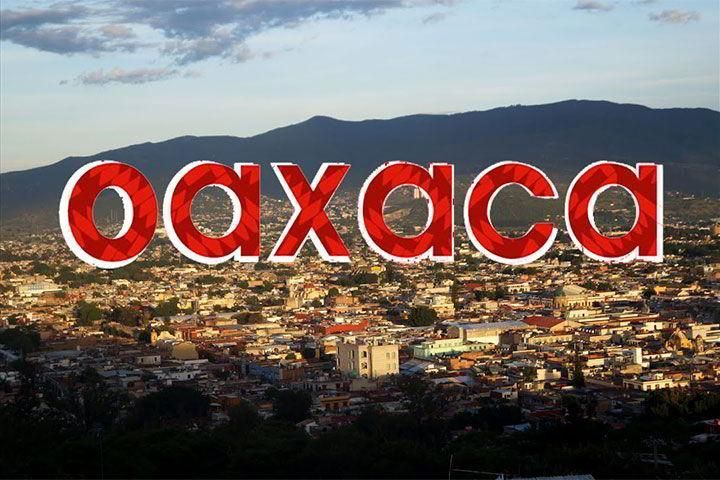
Temple of Santo Domingo de Guzmán
The center of Oaxaca and the archaeological site of Monte Albán were included in 1987 on the UNESCO World Heritage list. Its mix of Hispanic heritage styles such as baroque or churrigueresque merge with 20th century Art Nouveau performances.
Numerous public buildings, churches and government buildings were built with stone from the quarries of Oaxaca, with green stone such as the Cathedral, the Teatro Macedonio Alcalá or the Church of Guadalupe being especially beautiful.
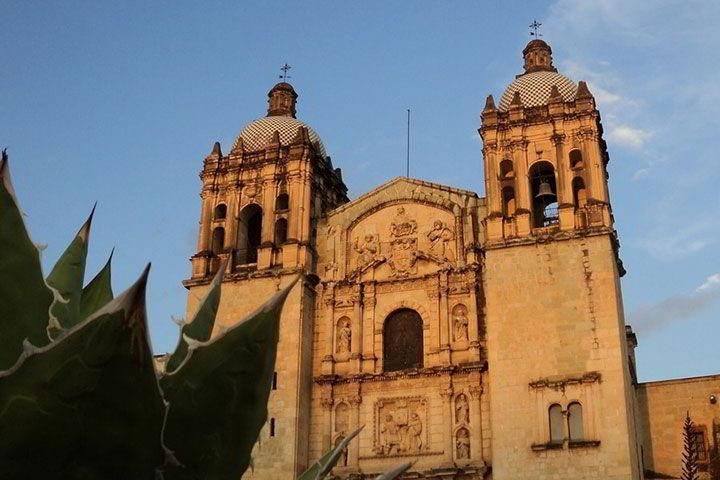
Without moving away from the Zócalo is the beautiful building of the Teatro Macedonio Alcalá, whose stalls and decoration remind us that it was built (1903-1909) following the most French-style classical cuts during the time of Porfirio Díaz's government at the beginning of the 20th century. In more than a hundred years, trials have taken place inside during the Mexican revolution, boxing evenings, film shows, operettas and jugglers. The theater was named after the famous composer who wrote the Waltz “God Never Dies.”
OAXACAN PAINTERS
Francisco Toledo
Francisco Benjamín López Toledo (Juchitán, Oaxaca, July 17, 1940) is a Mexican plastic artist who also has outstanding work as an activist, social fighter, environmentalist, cultural promoter and philanthropist. He has supported numerous causes focused on the promotion and conservation of the Mexican artistic heritage, oriented to free access to artistic training and care of the environment.
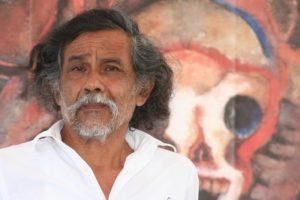
Francisco Toledo is considered one of the greatest living artists in Mexico, he has wide international recognition. He is an expert printer, draftsman, painter, sculptor and ceramist. His art reflects a great appreciation for the aesthetics of nature, particularly that of animals not conventionally associated with beauty such as monkeys, bats, iguanas, toads and insects. In his sculpture he has two forms of expression, one where he represents things from the natural world, specifically bestiaries of different animals, and another where he completely detaches himself from reality. “He forges, in this way, a universe that connects the dots with reality and, simultaneously, deploys the metaphor.”1 The latter can be seen in his work thanks to the fact that he represents human figures and other animals in a form of mating either explicit or symbolic.1 Toledo's moral vision affirms that the world of humans and animals are one with nature. Androgyny is greatly represented in his paintings1 Toledo uses modernity and the avant-garde of other civilizations, especially European civilizations, for his works 1 and shows a highly developed sense of the fantastic by creating anthropomorphic creatures that are at the same time monstrous and playful, characters which includes in its kites, artist books, masks, pieces of jewelry and complex engravings.2 Due to its works, it is said that Toledo belongs to the Generation of Rupture although it has not historically belonged to it.
He was the fourth of the seven children of Francisco López Orozco and Florencia Toledo Nolasco. At the age of 14 he began his artistic studies in the engraving workshop of Arturo García Bustos. Later he entered the Free Engraving Workshop of the School of Design and Crafts, of the National Institute of Fine Arts (INBA), in Mexico City. In 1959 he exhibited his works at the Antonio Souza Gallery and at the Fort Worth Center, in Texas. In 1960 he traveled to Paris, where he delved into engraving techniques, met museums, galleries, artists and writers that changed his vision of art. He returned to Mexico in 1965 with a new ideological and aesthetic perspective that he incorporated into his works.
His work is characterized by the irreverent, provocative and transgressive touch that he gives it. He developed his career as an independent artist, he did not get involved with the nationalist themes that the Mexican School represented. Although he has been associated with the Generation of Breakup that emerged in the 1950s, he maintains that he maintains his character as an autonomous artist.
The Zapotec artist has dedicated himself to promoting and disseminating the culture and arts of his native state, Oaxaca, where he currently resides. With the support of other institutions, he founded the Oaxaca Paper Art Workshop in October 1997, installed in the old hydroelectric plant "La Soledad" in San Agustín Etla. Within this context, he founded Ediciones Toledo, which in 1983 published his first book, and in 1988 he founded the Institute of Graphic Arts of Oaxaca (IAGO).
At his initiative, the San Agustín Arts Center (CASA) was created in 2006 in San Agustín Etla, 17 km north of Oaxaca de Juárez, the first ecological art center in Latin America, where photography, digital graphics are produced and studied. , textile design, as well as heritage preservation and art focused on the environment. Other projects that it has supported are: the Jorge Luis Borges Library for the Blind, the Manuel Álvarez Bravo Photography Center, the Museum of Contemporary Art of Oaxaca (MACO), the El Pochote Cinema Club, the Ethnobotanical Garden, the Eduardo Mata Sound Library, the Library Francisco de Burgoa, the magazines Guchachi Reza (Iguana Rajada) and Alcaraván, the Casa de Matemáticas de Oaxaca and many others.
Despite opposing public recognition, he has been awarded numerous awards, including the National Prize for Sciences and Arts in the area of Fine Arts in 19989 and the Prince Claus Award in 2000.10 In 2005 he received the Right Livelihood Award for his dedication to the protection and improvement of the heritage, environment and life of the community of Oaxaca. In 2007, the university council of the Benito Juárez Autonomous University of Oaxaca (UABJO) awarded him an Honoris Causa Doctorate for his work in the world of the arts. He designed the urn where the ashes of the writer Carlos Monsiváis rest since June 2011 in the Reading Room of the Museo del Estanquillo. The piece is made of clay painted in oil, which symbolizes a cat playing with a ball. Francisco Toledo, in 2015, handed over the Institute of Graphic Arts of Oaxaca (IAGO) to the National Institute of Fine Arts (INBA), a collection of more than 125 thousand objects, among which photographs from the 19th century and documents from the 20th century stand out, being Of the largest Donations, culturally speaking, included in the donation are two buildings, where the IAGO is currently located.
There are his works in the Museums of Modern Art in Mexico, Paris, New York and Philadelphia, in the New York Public Library, the Tate Gallery in London and the Kunstnaneshus in Oslo, among others. He has illustrated several books and has participated in numerous group and individual exhibitions in cities such as New York, London, Paris, Geneva, Oslo, among others.
Fountain:Wikipedia
Rufino Tamayo
Rufino del Carmen Arellanes Tamayo (Oaxaca, August 25, 1899 – Mexico City, June 24, 1991) was a Mexican modernist painter.
He is considered one of the most important Mexican painters of the 20th century, being also one of the first Latin American artists who achieved international recognition and dissemination of his work, as also happened with other artists such as the members of the well-known "group of the three» (Rivera, Siqueiros and Orozco).
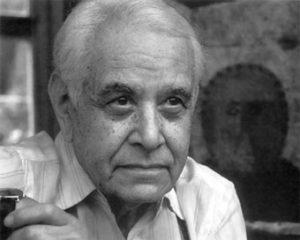
In fact, he worked with them on some projects, such as the muralist movement that spread during the period that included the two world wars; Despite the characteristics of his painting, they perfectly distinguish him from the rest of the group.
The museum that bears his name, Museo Tamayo Arte Contemporáneo, is dedicated exclusively to contemporary art and does not exhibit his work regularly.
He received an Honoris Causa Doctorate from the University of Manila in 1974; by the National Autonomous University of Mexico5 in 1978; for Berkeley in 1982; from the University of Southern California 6 in 1985; and for Veracruzana in 1991. He was named a full member of the National Academy of Fine Arts of Argentina.
Rufino Tamayo was born on August 25, 1899 in what is now the "Posada don Mario", located on Cosijopí Street No. 219, Historical Center of Oaxaca, very close to the former convent of Santo Domingo.
Son of Miguel Ignacio de Jesús Arellanes Saavedra Navarro, a shoemaker born in the City of Oaxaca, and Florentina Tamayo, a seamstress from Tlaxiaco, Oaxaca.9 The marriage separated in 1904, which meant for Rufino a change in his way of life, residing with her mother until 1911, she took her mother's last name after her parents separated. When Florentina died, she was left in the care of her aunt Amalia, who together with Rufino moved to Mexico City.2 10 11 Her His original desire was to become a musician, but he was so impressed upon arriving in Mexico City with the colonial architecture that, he said, “my eyes were opened in different ways.” Having the ability/skills to draw he realized that he wanted to be an artist.
With the idea that Rufino could help the family business (wholesale fruit) in the future, his aunt enrolled him in accounting school in 1914. However, he secretly took classes at ENEBA and it was not until 1917 that He formally enrolled in school.
He began his professional and academic education in 1915, when he entered the Academy of Fine Arts of San Carlos in Mexico City (1917).4 2 10 Until 1921, he remained as a student at ENEBA and Tamayo presents the school as a moment of rebellion in his life "the atmosphere at school was very unpleasant... Perspective is the art of reproducing things as they are seen... in a plan of rebellion I went out to paint in the courtyard because I did not agree with doing academic painting" .11 After the appointment of Ramos Martínez as director in 1920, Tamayo says, he opened the school to new trends and his commitment to the school shows a change, especially in the two then dominant currents, Ramos Martínez's neoliberalism and the naive aesthetics promoted by ENEBA.
In 1921 he left school and was employed as a draftsman in the ethnographic department of the National Museum of Archaeology, History and Ethnography, until 1926. He was present making drawings of popular art and pre-Hispanic pieces. At the same time he taught classes for the Ministry of Public Education. He was at ENEBA until 1929.
He began to exhibit his work relatively soon, holding his first exhibition in 1926. This exhibition brought recognition that allowed him to exhibit his works at the Art Center in New York.4 2 Upon his return from New York, Tamayo decided to join to the writers and artists associated with the newly founded magazine Contemporaneos, thanks to this influence and experience, Tamayo positioned himself as one of the key figures of the modern Mexican avant-garde.
In 1928, once he returned from his American adventure in New York, he worked as a professor at the National School of Fine Arts and, in 1932, he was named director of the Department of Plastic Arts of the Ministry of Public Education.
Many of his works between 1929 and 1938 reflect his relationship with Maria Izquierdo and the influence that the two artists had on each other.
In 1938 he received and accepted an offer to teach at the Dalton School of Art in New York, for which he moved to live in the American city, where he remained for almost twenty years, which caused a great evolution in the painter's artistic process. . He finished his training in New York, little by little putting aside his interest in European art to begin a new, more original stage in which he explored the “pictorial universe” in a personal way. Also produced in this artistic stage is the definition of its plastic language, which will be characterized by aesthetic rigor, perfection of technique and an ability to imaginatively transfigure objects, inspired by pre-Hispanic culture and the symbolism of pre-Columbian art.4
In 1933 he made his first mural, following a commission from the National Conservatory of Mexico. In this mural his break with the aesthetic assumptions of the works of the other muralists was evident.
In 1934 he married Olga Flores Rivas and lived with her until the end of his life.
Despite the importance and fame of his murals, Tamayo is, above all, an easel painter, one of his favorite themes being still life (representing objects, exotic fruits and also picturesque figures or characters) using a formal transmutation, with a symbolism. with intellectual roots and experimental aesthetics. Among his works can be named “Hippy in white” (1972), exhibited at the Museum of Modern Art, or “Two women” (1981), at the Rufino Tamayo Museum.
In 1936 he traveled as a delegate to the International Congress of Artists held in New York, receiving his first tribute, which earned him the appointment as professor of painting at the Dalton School.
In 1941 he painted one of the works that brought him the most fame, his painting “Animals”, and during the years 1940 and 1941, in his creation you can notice a demanding synthesis that shows the Picasso influence.
In 1943 Tamayo made what can be considered his first completely abstract work, “Nature and the Artist” (which can be seen in the Smith College Collection, Northampton, Massachusetts).
The Second World War and the launching of nuclear bombs in Nagasaki and Hiroshima radically changed the author's artistic perception, giving rise to telluric atmospheres in many of his paintings. The beginning of the space age also impacted his spirit and creativity, producing a plastic approach to the Universe. His fame has been increasing and currently, his paintings are exhibited alongside the work of: Balthus, Chagall, Matisse, Miró and Picasso.
He moved his residence to Paris from 1949, until the end of the 1950s. It was in 1950 when, following his participation in the XXV Venice Biennale, he achieved world renown and was considered a prominent artist of the 20th century. . At this time his painting is synthesized, creating “semi-abstract” paintings.
In any case, his international success was consolidated in the early 1950s, at the Venice Biennale where a Sala Tamayo was installed and later when he obtained the First Prize at the São Paulo Biennale (1953), together with the Frenchman Alfred Mannesier.
It is from this moment when the most productive stage of Tamayo's artistic life begins. Simultaneously, he began his fresco stage, creating frescoes both in Mexico (Palacio de Bellas Artes in the capital in 1952) and in other countries.
Among the murals he carried out, the following stand out: in 1953, he created the mural “El Hombre” for the Dallas Museum of Cinema Arts; “America” (1956), in Houston, United States, perhaps his largest mural; ; in 1957, for the library of the University of Puerto Rico, “Prometeo”; In 1958 he created a monumental fresco for the UNESCO Palace in Paris. In 1963 he carried out two murals to decorate the hull of the packet ship “Shalom: Israel Yesterday and Israel Today”. In 1964 he created the mural “The Day and the Night” for the National Museum of Anthropology and History of Mexico, symbolizing the fight between day (feathered serpent) and night (tiger). His last monumental works are from 1967 and 1968, when, for a government commission, he created the frescoes for the Mexican pavilions at the Montreal Exposition and at the San Antonio International Fair (Texas).
International recognition also comes through awards, recognitions and appointments to positions from artistic organizations around the world. In 1957 he had been named Knight of the Legion of Honor in France. In 1959 he was named Corresponding Member of the Academy of Arts of Buenos Aires and in 1961 he was chosen to join the Academy of Arts and Letters of the United States.
In 1964 he received the National Arts Award.
Fountain:Wikipedia
Rodolfo Morales
Rodolfo Morales (May 8, 1925 in Ocotlán de Morelos, Oaxaca – January 30, 2001 in Oaxaca de Juárez, Mexico) was a Mexican surrealist painter, who incorporated elements of magical realism in his work, such as the surrealist canvas titled "El dream". He was notable for his restoration of historic buildings in Ocotlán. Together with Rufino Tamayo and Francisco Toledo, he created a contemporary art center in Oaxaca to promote artistic creation. Both he and Francisco Toledo have been considered the most recognized artists in Mexico during the 1970s.
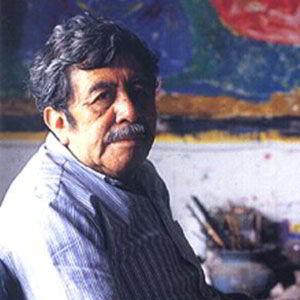
Born in Ocotlán de Morelos, Morales was a lonely child who often found solace in drawing. From 1948 to 1953 he studied art at the Academia de San Carlos in Mexico City. He qualified as a drawing teacher and began a 32-year career as an art teacher at the National Preparatory School Number 6, a position he held from 1953 to 1985.
In 1965, when organizing a Christmas party at the home of her friend and painter Geles Cabrera, she used collages as decorations. He liked his work and suggested a craft: a sculpture of a painting. This recognition encouraged Morales to concentrate all his efforts on painting and, to earn extra money, he organized exhibitions of his work in small galleries around the capital. In 1975, he was persuaded by Cabrera to hold his first solo exhibition at the mainstream Casa de las Campanas, the Art Gallery in Cuernavaca. Here his paintings caught the attention of the famous Mexican painter Rufino Tamayo who later helped establish contacts with art critics and galleries around the world, leading to a series of group and solo exhibitions.
Fountain:Wikipedia



